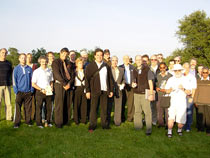

Tuesday - May 8, 2007
SLAC Today is available online at:
http://today.slac.stanford.edu
In this issue:
SLAC And CERN Collaborate in Testing a New Accelerator
Wellness Fair Tomorrow
Stanford Hosts Physics Teachers' Conference
Photo of the day: SPC Visits SLAC
Safety Seconds
 |
 |
|
Tuesday - May 8, 2007 |
|
Raquel Fandos, an electrical engineer from CERN, in the Next Linear Collider Test Accelerator control room at SLAC where she conducts experiments.
SLAC and CERN Collaborate in Testing a New AcceleratorParts of the Compact Linear Collider (CLIC)—CERN's experimental project to accelerate electrons in a unique and powerful way—are currently being tested at SLAC. Raquel Fandos, an electrical engineer from CERN, is using SLAC's Next Linear Collider Test Accelerator (NLCTA) in Endstation B to conduct trials of prototype accelerator structures that would be used at CLIC. This research is part of the CLIC feasibility study expected to be completed in 2010. Fandos' group at CERN wants to build radio-frequency accelerator structures that work at a gradient of 100 MV/m (accelerating electrons up to 100 MV per meter of machine) and produce 70-nanosecond pulses. "We have already reached those parameters with some structures," says Fandos. "However the breakdown probability is still too high, and we observe damage on the surface of the structures after a few weeks of testing." This is why Fandos is currently testing the sturdiness of different accelerator structures at the NLCTA, applying different combinations of pulse lengths and gradients in each trial to observe how many breakdowns occur in the devices in a certain period. This is the third time in two-and-a-half years that CERN personnel have come to SLAC to test CLIC parts, and Fandos says the collaboration between the two centers will probably increase in the future. Although CLIC was initially designed to work at an accelerating frequency of 30 GHz (the same level at which the test facility at CERN works), CERN recently decided to switch CLIC's frequency to 12 GHz, very close to the 11.424 GHz at which NLCTA operates, making the facilities at SLAC uniquely suited for testing the components of CLIC. |
||
|
|
||

Wellness Fair TomorrowThis year's Wellness Fair takes place tomorrow, May 9, from 10 a.m. to 3 p.m. in the Arrillaga Center for Sports and Recreation on Stanford's main campus. This year's fair is co-hosted by the Benefits Department and the Department of Athletics, Physical Education, Recreation & Wellness group. Representatives at the fair will offer the chance to: —Have your blood pressure, body fat, bone density, strength and flexibility, and cholesterol measured —Test your fitness with a Stanford fitness trainer —Enjoy healthy food demonstrations —Try out stationary bikes, elliptical trainers and rowing machines —Get a bike safety check —Learn more about ergonomically correct workstations and healthy work postures —Observe pilates, fencing, rock climbing, self-defense and yoga classes All Stanford employees are highly encouraged to attend this event. Learn more... Stanford Hosts Physics Teachers' Conference On Friday, May 4th, Vera Luth, Helen Quinn, and Susan Schultz hosted the opening ceremony and reception at SLAC for the Northern California American Association of Physics Teachers, a two-day conference at Stanford University. Helen Quinn kicked off the event with a guided tour of the visitor center; John Arthur presented a comprehensive overview of current SLAC research programs; and Tom Abel demonstrated his 3-D Tour of the Universe. |
Photo of the day:
|
Events (see all | submit)
Access (see all)Announcements
|
| | ||
|
|
||
 <%
Response.AddHeader "Last-modified", getArticleDate()
'Response.AddHeader "Last-modified","Mon, 01 Sep 1997 01:03:33 GMT"
'Monday, December 06, 2010
%>
<%
Response.AddHeader "Last-modified", getArticleDate()
'Response.AddHeader "Last-modified","Mon, 01 Sep 1997 01:03:33 GMT"
'Monday, December 06, 2010
%>View online at http://today.slac.stanford.edu/ |
||